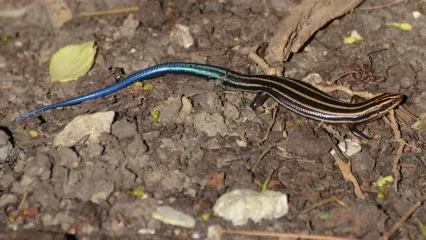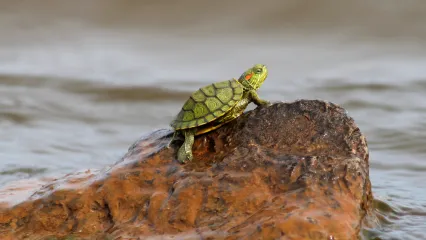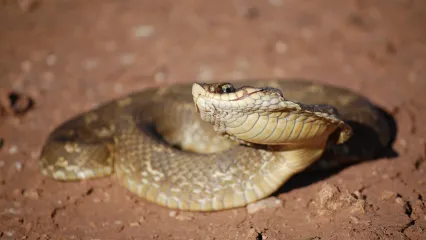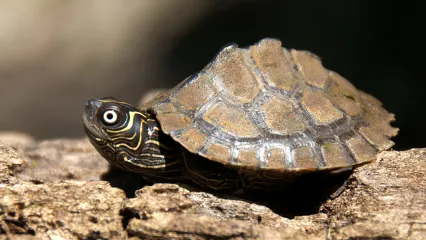
Description
Five-lined skinks are small to medium-sized lizards with smooth, glass-like scales, well-developed limbs, and a tail that is slightly longer than the body. They closely resemble the larger broad-headed skink in coloration and overall morphology. Juveniles are black with five distinct white stripes extending from the head to the first one-third of the tail. The stripes become less well-defined as the skinks age, with the background coloration fading to brown or tan. When sexual maturity is reached, the blue tails fade, with blue coloration disappearing completely within about a year following attainment of sexual maturity. Adult males lose the stripes completely and have a brown-tan body and tail. Stripes also fade in adult females, but most females retain at least some indication of the lateral stripes. A combination of size, coloration, and scale characteristics distinguish five-lined skinks from other skinks. Small, black skins with five white stripes and brilliant blue tails can only be five-lined skinks or broad-headed skinks. These two species can be distinguished as juveniles by counting the upper labial scales: five-lined skinks have seven with two post-labials whereas broad-headed skinks have nine, with no post-labials. In addition, the fifth upper labial is the first to contact the orbit of the eye in five-lined skinks whereas the sixth upper labial is the first to contact the orbit of the eye in broad-headed skinks. Size alone separate adult five-lined skinks from Great Plains skinks. Juvenile five-lined skinks will have five white or yellow stripes against a black background color whereas juvenile Great Plains skinks are black with no stripes.
Size
Large adult five-lined skinks can reach a little more than three inches in snout to vent length and no more than eight inches in total length. Males are larger than females and the heads of males are larger relative to body size than those of females. Many individuals have regenerated tails so that the ratio of tail to body length is reduced.
Habitat
In North America, the west-east distribution of five-lined skinks extends from central Oklahoma and Texas to Vermont and north-south from southern Canada and northern Michigan to the Atlantic Gulf Coast, including the northern one-third of peninsular Florida.
Life Cycle
Five-lined skinks are strictly diurnal and are usually associated with hardwood forests. Juveniles can be active on sunny days as early as March, but most activity of adults and juveniles occurs from April through November, depending on local climatic conditions. Mating occurs from May through June. During the mating season, heads of males turn bright red or orange as a result of hormonal changes associated with breeding. Males interact aggressively while courting females, and courtship behavior involves following a female for a prolonged time period prior to mating. Females deposit clutches of eggs varying from as few as 3 to 8 or more eggs in June and July. The number of eggs produced by females depends on size of the female; larger females produce more eggs than smaller females. Females construct nests in hollowed out areas, under hardwood logs or in rotted areas of hardwood logs under bark, and frequently under rocks. Females move in circular motion pushing rotted hardwood material or soil against the side of the nest chambers, essentially sealing it. Once the nest is constructed, the female lays the eggs, coils around them, and remains with the eggs until they hatch. Females frequently reposition the eggs, and sometimes leave the nest to feed, resealing the nest when they return. Respiratory water loss from the female helps to maintain the moisture in the nest necessary to maintain the developing embryos. Eggs hatch from late July through early September, and hatchlings are about one inch in snout-vent length, with the tail slightly longer than the body. No post-hatching parental care exists. Eggs within a nest hatch nearly synchronously, and both the females and the hatchlings abandon the nest when hatching occurs. Five-lined skinks are capable of living at least five years and likely longer. Sexual maturity is reached during the second year following hatching. Five-lined skinks feed primarily on small insects and spiders. Similar to other skinks, five-lined skinks use chemical cues to determine sex and reproductive status during social interactions and to discriminate prey. They avoid insects that produce chemicals for defense, such as many ants and beetles. The brightly-colored tails of juveniles are easily lost. Juveniles often flick the tail around when they bury their heads in leaf litter searching for prey. This behavior appears to distract birds and other potential predators away from the skink’s body and to the tail. Juveniles can regenerate their tails in about five weeks. When five-lined skinks reach sexual maturity, the tails lose their brilliant blue coloration and they are not as easily lost. Tails contain a large amount of stored energy, and if the female loses its tail during the breeding season, the loss of stored energy can reduce clutch size. Contrary to popular belief, tails are not pulled off by predators rather; the lizard initiates release of the tail, a process known as “tail autotomy [self loss].”
How To Observe
(This profile was created by Dr. Laurie Vitt as part of a partnership between the Wildlife Department and the Sam Noble Oklahoma Museum of Natural History. It was funded as part of a larger State Wildlife Grant to survey and inventory amphibians and reptiles of the Wildlife Management Areas of Oklahoma: T-35-P-1.)


